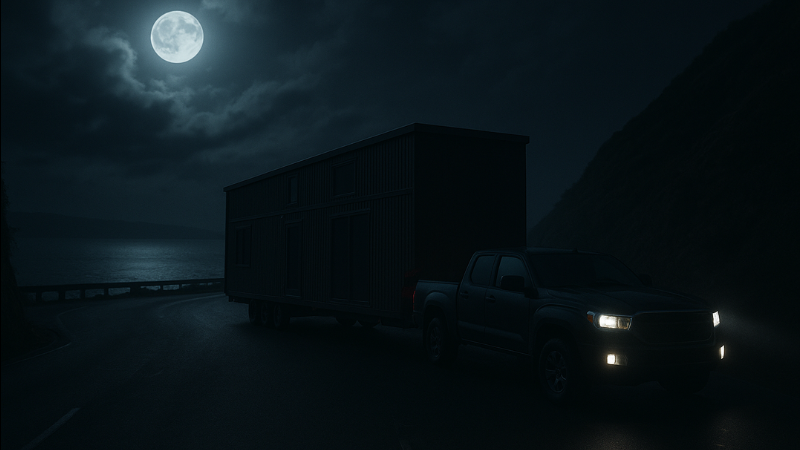It sounds like a bad joke: "What do you call a tiny house with wheels and no security? Missing. But for a growing number of New Zealanders, the punchline lands like a punch in the gut.
Over the past year, a spate of tiny house thefts has quietly swept across the country, from the rugged hills of Northland to the sleepy backroads of the Coromandel, Bay of Plenty, and Kapiti Coast. Entire homes, often painstakingly built with savings, sweat, and dreams of financial independence, have vanished in the dead of night. Each story follows a chillingly similar script: the owner arrives home to an empty patch of earth. The house, the furnishings, the solar setup, the memories… all gone.
Many are off-grid homes. Some were uninsurable. All are mobile, and that, is precisely the problem. If they know what they’re doing, theives can be off-site with your tiny home in 10 minutes flat.”
And once they’re gone they are hard to trace. Often repainted or modified to change their appearance, most leave no paper trail. In many cases, there’s not even a registration plate to track.
Andrew* had just finished building his tiny home in Northland. It was due to be lifted onto a permanent site, but it was stolen before this could happen. “It’s gutting. I built that house. I know every screw, every board. And now… someone’s sleeping in it, somewhere else.”
Like many tiny house owners, Andrew didn’t have insurance. Policies are difficult to secure, some providers still don’t recognise tiny homes on wheels as insurable dwellings. He asked that we not publish his full name while police investigations are ongoing.
Tiny houses, once the fringe dream of off-gridders and minimalists, are now a legitimate, and increasingly lucrative, alternative to traditional homes. With builds ranging from $40,000 to over $200,000, they’re a low-risk, high-reward target for opportunistic thieves.
Worse, the legal grey area surrounding tiny homes doesn’t help. Without a clear classification in many councils, and with few formal registration or ownership systems in place, the recovery process is patchy at best. People don’t steal what they can’t get rid of, they know tiny houses are a soft target. No VIN numbers. No GPS. No database. No deterrent. And ironically, some of the very rules designed to enable tiny living may be contributing to the problem.
Several councils, in their attempts to distinguish tiny homes from permanent dwellings, have strict conditions that the home must remain "moveable" at all times. In practice, this often means owners are discouraged from removing wheels or securing the trailer in any way that would make it harder to tow. Features like removable tow hitches or locked wheel clamps can be frowned upon, or even cited as non-compliant.
“It’s a catch-22,” says one builder. “If you make the tiny home harder to steal, you can fall foul of council rules. But if you follow the rules, you’re essentially making it easier for someone to hook up and take off with your tiny home.”
It leaves owners caught in a difficult balancing act, trying to satisfy local councils while also protecting what may be their biggest asset.
What You Can Do (Before It Happens to You)
While the law plays catch-up, owners are left to protect themselves. Here’s what you can do to make your tiny house less of a target:
GPS Tracking Devices:
This is the single best step you can take. Affordable tracking devices with real-time alerts can be discreetly installed in hidden spots inside your tiny home. While they won’t prevent a theft, they massively increase the chances of getting your house back quickly, and in one piece. New Zealand-based providers like Feetpin offer tiny house owners local support and reliable systems tailored for off-grid or mobile living.
Block It In:
If possible, park your home in a way that requires significant effort to move, boxed in by other vehicles, fences, or on a locked site.
Security Cameras and Trail Cams:
Motion-activated cameras can help identify thieves, or at least scare them off. Dummy cameras are cheap and still act as deterrents.
Wheel Locks and Tow Ball Locks:
Install quality locks designed for caravans or trailers. Cheap ones can be smashed off in seconds, invest in heavy-duty gear.
Mark and Register:
Engrave your name and phone number in hidden places (under floorboards, behind panels). Keep a record of serial numbers for appliances and equipment. Photograph the house from all angles.
Community Watch:
Keep your neighbours informed. The tiny house community is tight-knit and highly alert. Sharing suspicious activity could be the difference between recovery and a cold trail.
Tiny homes are a brilliant way to live, affordable, flexible, and full of freedom. But that freedom also means they’re ridiculously easy to tow away if you haven’t made any effort to stop someone doing exactly that.
It’s a hard truth, but here it is: if your tiny house is on wheels, it can easily be stolen, GPS trackers, wheel locks, tow ball locks, cameras, none of these are expensive compared to losing your entire house. It’s not paranoid to prepare for theft. It’s practical. Like brushing your teeth so they don’t fall out, or not leaving your keys in the ignition with a sign that says, “Please return by Monday.”
Because at the end of the day, the best deterrent isn’t hope, or a post in your local Facebook group, it’s actually doing the boring stuff that makes your house annoying to steal.
Make it difficult. Make it traceable. Make it not worth the effort.
And whatever you do, don’t just assume that tiny house theft is something that happens to other people. That’s what everyone thought, right up until it wasn’t.


